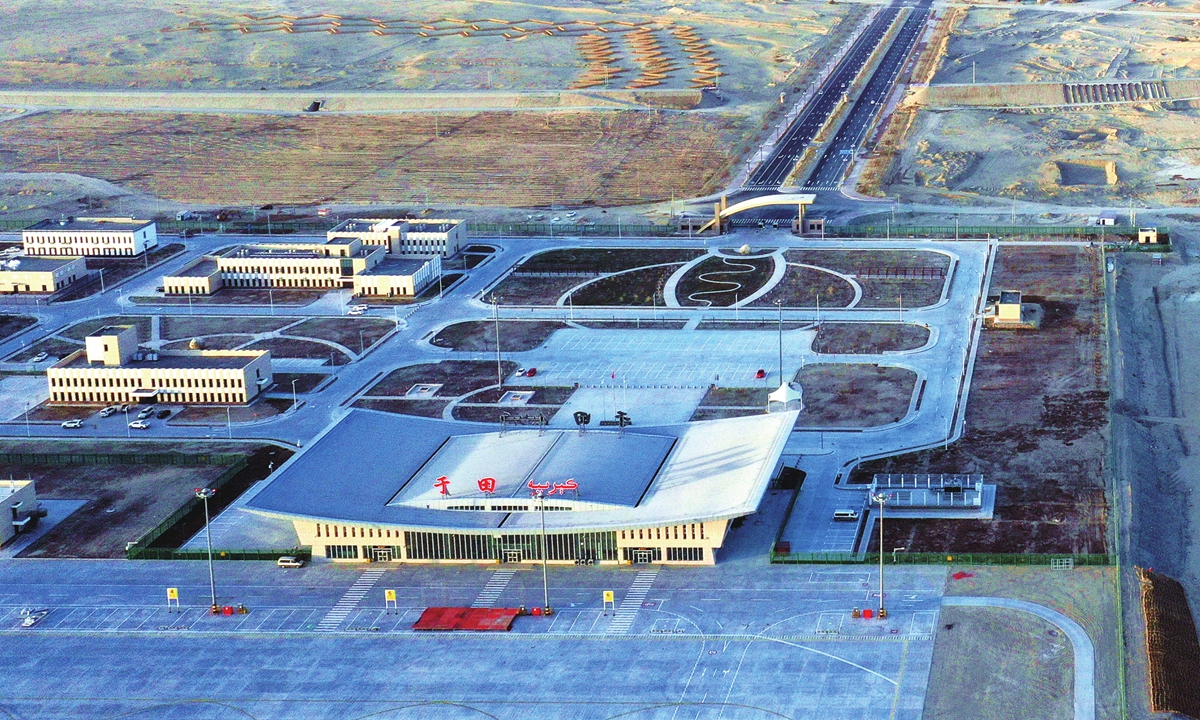
The Wanfang Airport in Yutian county in the Hotan prefecture of Northwest China's Xinjiang Uygur Autonomous Region Photo: VCG
As China shifts up a gear in the development of its vast western region, which covers more than 70 percent of the country's landmass, China will further open its economy and share its quality resources, such as the market, with the world, so as to build mutually beneficial cooperation. In this process, the Belt and Road Initiative (BRI) will establish an effective platform to meet the development needs of the world.
The China-Europe Railway Express, a flagship project under the BRI, has deepened connectivity and boosted common development in the Eurasian continent over the past decade. On Friday, a train carrying agricultural products reportedly left Urumqi, Northwest China's Xinjiang Uygur Autonomous Region, for Salerno, Italy. The route, combining rail and ocean services, not only reduces transportation costs and improves the efficiency of international cargo shipments, but also shortens the overall time by half compared with sea transportation.
The China-Europe Railway Express has significantly improved railway connectivity between Asia and Europe, as well as the development of sea-rail, road-rail and air-rail multimodal transportation, offering strong support for the massive trade of goods between China and Europe. Enormous potential remains to be tapped in bilateral trade, as China makes tremendous efforts in boosting the high-quality development of its western region by pursuing higher-standard opening-up.
With China's push for more balanced development, the economic gap between China's better-off eastern coastal region and its less-developed western inland region is narrowing. The western region is expected to catch up with the eastern region in the fields of public service, infrastructure connectivity and living standards by 2035. It means the vast western region has significant growth opportunities in the foreseeable future.
Xinjiang can be viewed as the epitome of the development of China's western region. Xinjiang's GDP jumped 5.6 percent in the first quarter with its growth exceeding forecasts. The added value of its secondary industry reached 188.36 billion yuan ($25.99 billion), up 10.1 percent year-on-year, exceeding the increases in the primary and tertiary industries. This added to evidence that Xinjiang's industrialization has accelerated and taken off, and is growing at an extraordinary pace.
The first wave of China's industrialization and modernization brought development to the eastern and southern parts of the country. The second wave will soon lift up the country's vast western region. The urbanization and industrialization of the central and western parts of China will not only inject new impetus into the country's economic development, but will also advance a new round of opening-up.
Further opening-up can help bolster the efficiency and competitiveness of Chinese markets, while relieving pressure on the global economy. The BRI is expected to be an important part of China's new round of opening-up, letting the world share the growth dividend of the second wave of China's industrialization in its western region.
The BRI continues to develop rapidly. As the initiative has materialized over the past decade, Xinjiang has been transformed from a relatively closed inland region to a frontier of opening-up and innovation. With the rise of China's western region, BRI cooperation will become even more valuable for overseas partners.
China still has golden opportunities for development. How can this potential be tapped? Europe should be more involved in the BRI. Some in the West incorrectly claim that Europe can gain little from its participation in the BRI, but the initiative connecting Europe with China's fast-growing western region counters this point.
Rapid economic development has created a large demand for imports. In 2023, Xinjiang's foreign trade totaled 357.33 billion yuan, a year-on-year increase of 45.9 percent, ranking second among China's provincial-level regions in terms of growth. If China's western region can further accelerate its industrialization and urbanization with the help of the BRI, it will have a profound and long-term impact on the global supply chain. Foreign businesses should not miss emerging opportunities in the Chinese market.



